|
CHINA SCIENCE AND TECHNOLOGY
NEWSLETTER
The Ministry of Science and Technology
People's Republic of China
|
|
|
N0.521 |
August 30,2008 |
|
|
|
|
|
|
|
|
IN THIS ISSUE
|
|
* MOST Collaborates with China Merchants Bank for Proprietary Innovations
* MOST and CBRC Financing S&T Activities
* China’s 100 Billion S&T Expenditure
* Quantum Repeater Node Realized
* Loongson III’s 4-core Version
*Dawning 5000A Off Assembly Line
|
MOST Collaborates with China Merchants Bank
for Proprietary Innovations
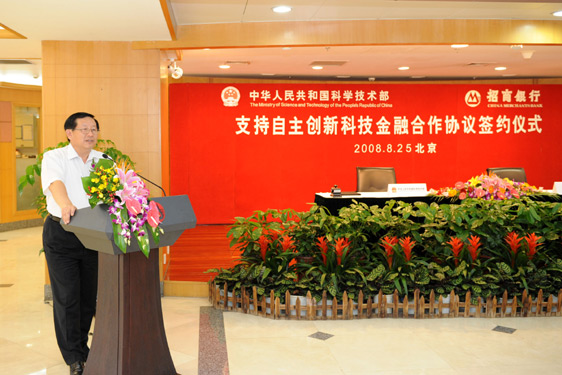
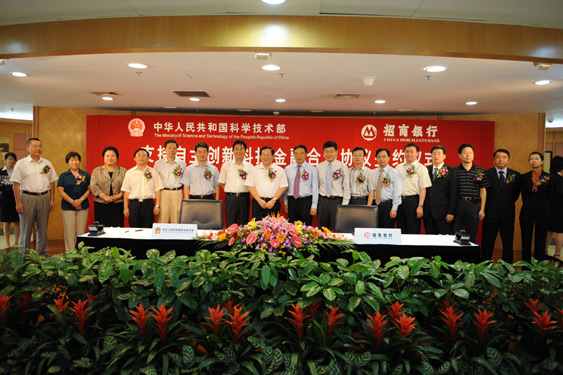
The Chinese Ministry of Science and Technology singed on August 25, 2008 an agreement with China Merchants Bank to support innovation activities. Both sides agreed to create a new path for raising money for innovation activities, through both government policy guidance and commercial loans, under the principle of “MOST organizes innovation activities, CMB independently examines loan applications, relying on the collaborating platform, and operating in line with the market principle”. WAN Gang, Vice-Chairman of the Chinese People’s Political Consultative Conference, and Minister of Science and Technology, and MA Weihua, President of China Merchants Bank spoke at the signing ceremony. LIU Yanhua, Chinese Vice Minister of Science and Technology, and ZHANG Guanghua, Vice President of China Merchants Bank inked the accord.
According to the agreement, China Merchants Bank will, during the term of cooperation, provide banking service for national S&T programs, major special S&T projects, small and medium tech businesses, venture capital investment, and projects involving energy efficiency and emission reduction. MOST will play the role of policy guidance, organizing and coordination, by taking advantage of its strength in projects, expertise, and information. China Merchants Bank will support China’s high tech development by providing banking service for product innovation activities at small and medium businesses.
MOST and CBRC Financing S&T Activities
WAN Gang, Chinese Minister of Science and Technology and LIU Mingkang, Chairman of China Banking Regulatory Commission (CBRC) had a working meeting on August 20, 2008 to discuss the financial support for small and medium tech businesses.
WAN thanked CBRC for its long standing support for S&T activities. He pointed out that the marriage of S&T activities and banking is an important direction that both S&T activities and economic activities should go in, allowing the banking business to lead S&T business into the marketplace. WAN also briefed CBRC about the overall development of small and medium tech businesses in 55 national high tech parks. He proposed a range of initiatives on establishing a guarantee system for S&T businesses, strengthening the integration of S&T and banking resources, staging a pilot project for intellectual property based loan making, and equity investment in innovation activities by the banking system.
LIU introduced the practice and comments of CBRC on facilitating fund raising activities at small and medium tech businesses. He pointed out that banking institutions shall enhance their support for the development of S&T businesses, and the banking market shall facilitate the fund raising efforts of S&T businesses. Small and medium tech businesses’ difficulties in raising needed fund is a systematic issue that should be addressed in line with the principle of market, by establishing a multi-tiered, multi-phased, and multifunctional banking support system, allowing more direct financing, bank loans, venture capital investment, directional private placement, and tech board listing, with an enhanced guarantee system.
Both MOST and CBRC will establish a collaborating mechanism in the near future, to encourage and guide banking institutions to enhance their support for proprietary innovations activities, using their respective strength. Pilot projects will also be staged to create a fine environment for fund raising activities at small and medium tech businesses.
China’s 100 Billion S&T Expenditure
In 2007, China’s S&T expenditure has reached RMB 99.961 billion, or 3.4% as a proportion of state treasury expenditure in the same year, said XIE Xuren, Chinese Minister of Finance, on August 27, 2008 in his 2007 financial report. XIE pointed out that the state treasury has enhanced its input in the National Natural Science Foundation, supporting more public good R&D activities and the development of national labs and national key labs. Meanwhile, the Chinese government has made more money available to support proprietary innovation activities of small and medium tech businesses. In 2007, China has seen an increasingly optimized expenditure structure, with more weight on farming, education, medicare reform, social support, culture, ecological reconstruction, and environmental protection.
Quantum Repeater Node Realized
Prof. PAN Jianwei and his coworkers Z.S. YUAN and Y.A. CHEN at the University of Science and Technology of China have for the first time in the world offered efficient and secure ways for the exchange of information in a network, using cold quantum memory techniques. Two atomic ensembles, each originally entangled with a single emitted photon, are projected into an entangled state by performing a joint Bell state measurement on the two single photons after they have passed through a 300-m fibre-based communication channel. The entanglement is stored in the atomic ensembles, and later verified by converting the atomic excitations into photons. The method is intrinsically phase insensitive, and establishes the essential element needed to realize quantum repeaters, a solid step towards the final realization of a wide area quantum communication network in the future. The finding with a title of Experimental demonstration of a BDCZ quantum repeater node was published in the August 28, 2008 issue of journal Science.
Pan and his coworkers realized entanglement exchange and purification in 1998 and 2003 respectively. However, quantum memory has long been proved a technical difficulty in the lab. PAN and his coworkers proposed in 2007 a theoretical plan to work on effective quantum repeaters equipped with memory functions but with less sensitivity to the vibration of transmission channels and low coding errors. Meanwhile, in collaboration with their coworkers in Germany and Austria, PAN and his team have eventually realized the quantum repeaters, based on a range of phased results, including photon-atom entanglement, photonic qubits, atomic qubits, and hidden quantum transmission.
Tibet Plateau Grasslands’ CH4 Emission
Not long ago, a study team, jointly led by CAO Guangmin, a research fellow with CAS Northwest Institute of Plateau Biology, and XU Xingliang, an associate research fellow at CAS Institute of Geographic Sciences and Resource Research, has published its latest findings on grasslands CH4 emissions across the Qinghai-Tibet Plateau in the recent issue of Biology Letters. The report is the first of its kind so far published in the scientific community.
Researchers made a three-year long observation of CH4 emissions of two types of alpine grasslands, using a closed chamber method. Study results show that alpine grassland vegetations play an important role in the earth CH4 cycle. Meanwhile, one has to take into account the type of plants and associated growing environment when dealing with the contributions of alpine grasslands to the atmospheric CH4.
Chinese scientists have found through the study powerful evidences showing the massive CH4 released from plants, though such capability varies by type of plants. The study also confirms the fact that the CH4 released from plants are differed by species as well as by natural environment.
Loongson III’s 4-core Version
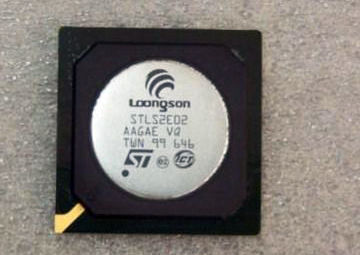
Loongson III
Chinese made Loongson III will make the debut of its 4-core version at the end of the year, and an 8-core version in 2009, said XU Zhiwei, Deputy Director of CAS Institute of Computing Technology at Hot Chips held recently in California. The core configuration of Loongson III was displayed at the show. According to XU, Loongson III consumes little power, with 10w for the 4-core version, and 20w for the 8-core version. Using MIPS64 as the inner core, Loongson III has been added with more than 200 commands for binary conversion and multimedia acceleration. XU also said China will make Loongson III a supercomputer in 2010, enjoying 1,000 trillion floating-point operations per second. Loongson III will eventually be applied to the desktop at the Teraflops level.
Chinese Herb Ease Dementia
Thanks to a 3-year study, headed by YU Nancai, pharmacist in chief at Wuhan No. 1 Hospital, researchers have found that Portulaca oleracea L, a Chinese medicinal herb, can effectively protect the injured brain tissues, and enhancing people’s immunity. Using molecular biological means, researchers have identified numerous effective medicinal elements in the herb, including isoflavone, saccharoids, vitamin C and E. Frequent eating Portulaca oleracea L may boost brain functions. In China, the herb has long been deemed as a vegetable that may help to prolong one’s longevity. In the past, most people only knew that the herb was able to release heat and reduce toxicity, and mainly used it to treat inflammations and diarrhea. Wuhan Municipal S&T authorities recently organized an expert validation check, which has led to the conclusions that the herb is of the effects of easing senior decay, and preventing dementia.
CSTAR 135-day Observation at the Dome A

CSTAR on the Dome A (January 12, 2008)
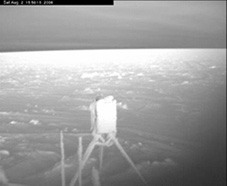
Winter observation at the Dome A (August 2, 2008)
CSTAR, jointly developed by the Nanjing Institute of Astronomic Optics, the Purple Mountain Observatory, and the National Astronomic Observatories, all affiliated to the Chinese Academy of Sciences, was installed January 12, 2008 on the DOME A, an Antarctic plateau. It sent back on March 20, 2008 a clear star picture, and started to make observation. As of August 2, 2008, the telescope has been making observation for 135 days, including the winter time observation at the DOME A. It has recorded and sent back numerous star pictures surrounding the area, which have been turned into consecutive optic variation curves. Scientists have found a range of variable stars, and collected important information on site selection, including the number of consecutive clear nights, sky luminance, and cloud cover at the DOME A through the observation.
Second Evaporator Cone Ready
Not long ago, China First Heavy Industry rolled out a second evaporator cone for the 3rd generation nuclear reactors, using a 15000-ton hydraulic press. To address the technical difficulties for directly forging the straight sections for both ends of the cone, technicians have calculated the technical parameters of each fire time in the forging process, and worked out a range of process supporting tools. They managed to reduce one fire time by positioning the mold in a better position, with a raised efficiency by 70% for a prolonged fire time.
Before this, China First Heavy Industry has developed an AP1000 evaporator cone, the first key component for the 3rd generation nuclear power generator in the world. The development marks China’s leading position in manufacturing the 3rd generation nuclear power generator in the world.
Dawning 5000A Off Assembly Line
Dawning made the debut in June, 2008 of a Dawning 5000A computer, with 100 trillion floating-point operations per second, the first of its kind in the country. The development makes China the second country after the United States in the world able to produce a high performance computer at this level. Dawning 5000A computers will soon be off the assembly line.
More Thermal Fluid Activities Found
Ocean I, a scientific expedition vessel cruised over the east part of the Pacific Ocean, had spotted on August 23-24 two thermal fluid activities zones near the equator. This is the first instance of spotting thermal fluid activities near the equator in the east part of the Pacific Ocean, and China’s second discovery of the same activities following the first discovery of a sea floor thermal fluid activities zone in the southwest part of the Indian Ocean in 2007.
China’s Super Thin LED TV
Hisense recently made the debut of its super thin 42’ LED TV in the market. The new product enjoys the following features: red and green high color, high bright LED, a color that is much better than CCFL, a resolution reaching 1920x1080, and a thickness of only 55mm, making it the thinnest LED TV in the world. The new TV has a power consumption of only 150W, with the lowest consumption at 50W. It has a white bright of 500 nits or more, with a dynamic contrast as high as 40000:1, and a dark picture effect that is much better than CCFL. Researchers have worked out the solutions to a range of technical difficulties for making the new product, including high color illumination unit and module, super thin optic design, a highly efficient heat dissipating structure, dynamic driving technology, self-adaptive backlight control algorithms, and FPGA design. The development of the product has resulted in 10 domestic and international invention patent applications.
Proprietary Hydrogen Fuel Buses into Operation
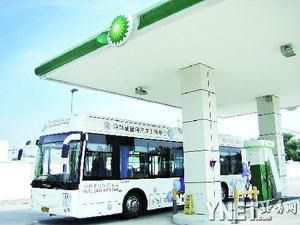
During the period of the Beijing Olympic Game, some 500 buses using diverse new energies were put into operation. A hydrogen gas station was established at the new energy demonstration park in the Yongfeng High Tech Center in Zhongguancun. Covering an area of 4000 square meters, the hydrogen gas station is equipped with advanced gas producing facilities, including hydrogen gas maker, natural gas reformation device, and clean hydrogen gas maker. All the fuel battery cars and buses demonstrated at the Beijing Olympic Game have been maintained and refueled at the station. It takes some 20 minutes to get a fuel battery car or bus refueled, for a run as far as 250 kilometers. A fuel battery car or bus will have to get refueled approximately once a day.
According to a briefing, the new energy demonstration park has a two-phased construction plan. In Phase I, a hydrogen gas station was established in October 2006 for hydrogen storage, refueling, and fuel battery car or bus maintenance. Phase II has led to the construction and full operation of a new energy innovation center, a new energy education center, and an on-the-spot hydrogen making facility.
Comments or inquiries on editorial matters or Newsletter content should be directed to:
Mr. XU Chaoqian, Department of International Cooperation, MOST 15B, Fuxing Road, Beijing 100862, PR China Tel: (8610)58881360 Fax: (8610) 58881364
http://www.most.gov.cn |

